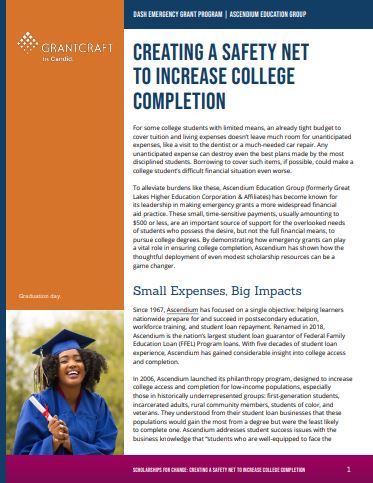Creating a Safety Net to Increase College Completion
For some college students with limited means, an already tight budget to cover tuition and living expenses doesn’t leave much room for unanticipated expenses, like a visit to the dentist or a much-needed car repair. Any unanticipated expense can destroy even the best plans made by the most disciplined students. Borrowing to cover such items, if possible, could make a college student’s difficult financial situation even worse.
To alleviate burdens like these, Ascendium Education Group (formerly Great Lakes Higher Education Corporation & Affiliates) has become known for its leadership in making emergency grants a more widespread financial aid practice. These small, time-sensitive payments, usually amounting to $500 or less, are an important source of support for the overlooked needs of students who possess the desire, but not the full financial means, to pursue college degrees. By demonstrating how emergency grants can play a vital role in ensuring college completion, Ascendium has shown how the thoughtful deployment of even modest scholarship resources can be a game changer.
Small Expenses, Big Impacts
Since 1967, Ascendium has focused on a single objective: helping learners nationwide prepare for and succeed in postsecondary education, workforce training, and student loan repayment. Renamed in 2018, Ascendium is the nation’s largest student loan guarantor of Federal Family Education Loan (FFEL) Program loans. With five decades of student loan experience, Ascendium has gained considerable insight into college access and completion.
In 2006, Ascendium launched its philanthropy program, designed to increase college access and completion for low-income populations, especially those in historically underrepresented groups: first-generation students, incarcerated adults, rural community members, students of color, and veterans. They understood from their student loan businesses that these populations would gain the most from a degree but were the least likely to complete one. Ascendium addresses student success issues with the business knowledge that “students who are well-equipped to face the academic, financial, and personal challenges of college are the most likely to graduate.” Through its education philanthropy program, Ascendium has provided over $300 million in grant support since 2006 and contributed a record amount of $107 million in 2018. Every initiative they fund falls into one of three categories: exploration grants to support new ideas, validation grants to build an evidence base, and scaling grants to replicate effective practices. The Dash Emergency Grant program started as an exploration grant and evolved into both validation and scaling iterations.
Exploration: Filling a Gap
In 2012, the Ascendium education philanthropy team posed this pivotal question: “Would making small grants to students facing unforeseen financial emergencies reduce the number of students who drop out?” In other words, could a small grant make the difference in college success? The Dash Emergency Grant program explored whether small interventions could make a significant difference.
During the initial three-year phase of the Dash Emergency Grant program, Ascendium committed almost $1.5 million to fund student grants and cover related administrative expenses at each of the 16 two-year colleges within the Wisconsin Technical College System (WTCS). The participating institutions were required to provide up to 25 percent of the grant amount made available by Ascendium. An average grant of $500 was made to almost 2,700 students attending WTCS colleges. Amy Kerwin, who leads education philanthropy for Ascendium, heard through her conversations with student service leaders that the emergency grants program was also “opening their eyes to student needs that were unknown to them.” For example, when they discovered that 75 percent of the students on one campus suffered from food insecurity, campus officials better responded to that basic need by connecting students to federal SNAP (food stamp) benefits.
Grants made by colleges through the Ascendium Dash Emergency Grant program were generally used for expenditures related to transportation, housing/utilities, medical/dental, child care, food and similar basic purposes. These students from Milwaukee, Wisconsin area higher education institutions offer examples of how the emergency grants have been used:
- University of Wisconsin-Milwaukee student Amber Brewer paid for her health insurance and utilities after an ankle surgery.
- Alverno College student Jieneen Metcalf addressed multiple unpaid bills for transportation, rent, and utilities that piled up after an unexpected health crisis.
- Cardinal Stritch student Pearl Goodwin paid her utility bill, which was higher after moving to a new neighborhood.
Beyond providing a short-term fix, the emergency grant offers the first step in a pathway to greater financial stability for these vulnerable college students. According to Kerwin, the emergency grant often served as an “enticement”—these students are “incentivized” to seek help from their colleges, and reveal, without embarrassment, painful personal concerns that are often concealed. Knowing that caring adults are also available to them, these students are then more willing to seek assistance before a small unmet need cascades into a semester-ending, or degree-ending decision.
Validation: Success Factors
In its first phase, the emergency grant program achieved an astonishing level of impact: Participating WTCS colleges reported that “73 percent of Pell-eligible emergency grant recipients either graduated or remained enrolled. By comparison, the National Center for Education Statistics reports a 59 percent retention rate for all students at public two-year institutions.” Emergency grants improved retention, a critical factor for college completion, by almost 24 percent. In short, filling small gaps was helping to ensure higher rates of student success. Affirming evidence was conveyed along with other important lessons in Ascendium’s “2012-2015 Emergency Grant Closing Report and Best Practices”. As stated in the report, “Sometimes these students need large-scale interventions to assist them. Other times, only a small boost.”
The grant closing report also recognized that the most important factor in determining impact was the level of institutional commitment—could the campus mobilize the human, financial, and technical resources to respond quickly to a student’s need? As cited in the report, the following best practice actions by campuses contributed to the overall level of program effectiveness:
- Promote the availability of the emergency grants.
- Inform faculty of the program benefits.
- Provide a positive message to students.
- Agree on the definition of financial emergency.
- Identify the cause of the financial emergency.
- Coordinate among student services, financial aid, and business offices.
- Expedite the review and disbursement process.
- Address patterns of chronic financial emergencies.
- Document procedures for purposes of training and improving.
- Address program sustainability through fundraising.
- Connect with and learn from other institutions.
Researcher Sara Goldrick-Rab, professor of educational policy studies and sociology at the University of Wisconsin-Madison and founding director of the Wisconsin HOPE Lab, spoke to the true value of emergency grants by saying, “By complementing the existing financial aid system, and helping to compensate for some of its key weaknesses, emergency grants can help ensure that students have their basic needs met so that they can focus on their education.”
Scaling Success
 Based on the results of its 2012-2015 pilot, Ascendium then began a process of program scaling through its own direct support as well as the dissemination of Dash Emergency Grant program best practices to other philanthropies concerned with college student success. According to Kerwin, they became better able to discern if an institution was both “willing and able” to operate an emergency grant program. In the first round, some institutions were willing, but not able, and some were not even willing. In late 2015, Ascendium provided a second round of $1.5 million for emergency grants at 31 technical and community colleges across Iowa, Minnesota, Ohio, and Wisconsin.
Based on the results of its 2012-2015 pilot, Ascendium then began a process of program scaling through its own direct support as well as the dissemination of Dash Emergency Grant program best practices to other philanthropies concerned with college student success. According to Kerwin, they became better able to discern if an institution was both “willing and able” to operate an emergency grant program. In the first round, some institutions were willing, but not able, and some were not even willing. In late 2015, Ascendium provided a second round of $1.5 million for emergency grants at 31 technical and community colleges across Iowa, Minnesota, Ohio, and Wisconsin.
In 2017, Ascendium expanded the emergency grant program with a commitment of $7.2 million awarded to 32 four-year institutions in their six core funding states of Arkansas, Iowa, Minnesota, North Dakota, Ohio, and Wisconsin. Eligible institutions needed to show evidence of their capability to implement the program, and matching funds designated for emergency grants—10 percent in the first year and 15 percent in the second year. Institutions chosen for support were also required to commit to sharing student enrollment data in order to further understand the impact of emergency grants on student retention and persistence. According to Kerwin, Ascendium sought colleges and universities that were best able to act as learning partners—“dig in with us”—and then institutionalize their experience with emergency grants. In other words, the Ascendium funding was not just a “pass through” of funding to needy students, but rather a powerful means of examining and improving the institution’s own ability to support low-income student success.
Given the large-scale national need for such emergency grant resources, Kerwin and her colleagues have published “A Broader View of Emergency Aid: Toward a More Holistic Approach to Helping Students Weather a Financial Crisis” to share more lessons learned with both private and public funders. They also funded the development of Training for Emergency Grant Decision-Makers, a toolkit for emergency grant decision-makers to help them navigate the difficult choices that come with awarding emergency grants to students in financial distress. With compelling evidence of the small cost and high impact of emergency grants on the lives of low-income college students, Wisconsin lawmakers approved $425,000 in public funds for this purpose in 2016. As Kerwin summed up, “Our biggest desire is that others can learn from those who have gone before them.” In exploring, validating, and now scaling emergency grants, Ascendium has begun to meet the unforeseen needs of all students who are determined, despite any and all obstacles, to make better lives for themselves and their families.
For more on Ascendium Education Group visit ascendiumphilanthropy.org.
This case study is one of 12 in a suite of case studies focused on how donors are supporting scholarships to create change. The case studies have been developed in companionship with Candid’s project Scholarships for Change, a dynamic hub that pulls together data and knowledge to tell the story of how philanthropic dollars are supporting transformative scholarships.





